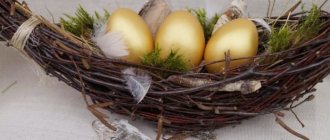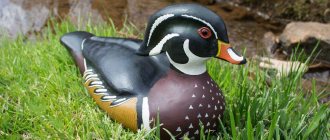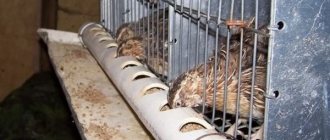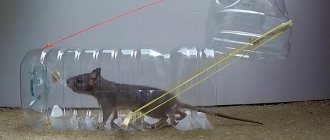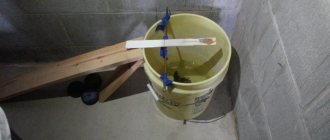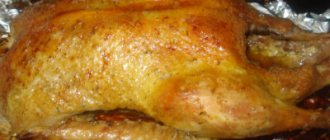There are a huge number of instrumental calls that originate from a vibrating leaf or blade of grass, pressed between the fingers and producing rattling sounds of various tones. Hunters make homemade decoys of this kind on the spot; they do not carry them with them, since the material is always at hand and is found in abundance. For example, the crackling signal of a magpie is well reproduced by a half-empty matchbox, and the sharp cry of corncrakes is perfectly imitated by a comb if you run a sliver of wood over it.
Homemade duck decoys, design and production.
Some hunters are very good at imitating the voices of wild ducks and luring them in without a decoy. Simply with the help of your lips and a cupped palm. It is quite difficult to learn this, so it is better to use special decoys that you can easily make yourself. If you have at least some ear for music, every hunter can learn to use them.
The teal decoy consists of a horn, a peep and a mouthpiece; the squeaker, in turn, is made up of a wedge, a tongue and a groove. The simplest teal decoy is made as follows. A jacketed bullet of 7-8 mm caliber is ground off from the side to about 1/4 of the thickness, the lead is melted out and the remaining jacket is cleaned inside with sandpaper. A tongue of such size is cut out of a thin brass plate (0.1-0.2 mm) that when applied to the shell, it completely covers its sawn-off part.
The shell with a tongue placed on top is tightly inserted into the half of a regular spool of thread (with the open end inside the spool) to a depth of 5-6 mm and secured in it with a specially cut wooden wedge. The wedge should be half the length of the bullet shell (groove), and the thickness and cross-sectional shape should be sufficient to securely hold the groove in the reel, press the tongue tightly against it and completely cover the part of the reel hole remaining above the groove and tongue.
The end of the groove and the tongue covering it protruding from the coil should be 7-10 mm free from the wedge. The resulting squeak must be taken into the lips so that the free ends of the tongue and groove are in the mouth, and blow into it. Air passing through the groove vibrates the tongue plate.
Number of reeds
A duck decoy can have from one to three reeds. The sound quality of the decoy and the ease of use depend on the number of reeds.
- Single-tongued decoys are superior in sound quality to all other decoys; the sound of such decoys is the most realistic, sonorous and rich. They practically do not stick due to humidity. Difficult to master for novice hunters, the slightest error in sound extraction becomes immediately noticeable.
- Double-tongued decoys - recommended for use by novice hunters. Double-tongued decoys forgive many of the mistakes of a novice caller; mistakes do not affect the sound quality. The disadvantage of a two-tongue decoy is that it sticks much more often and more strongly than a single-tongue one. Sticking of the semolina occurs due to the ingress of moisture from the breath of the decoy operator into the decoy. The sticking of the decoy is greatly influenced by the design of the decoy and weather conditions during hunting.
- Three-tongue decoys are found and used much less frequently than single- and two-tongue decoys. The sound quality corresponds to a two-tongued decoy. Sticks as well as a two-tongue one or even a little more. Not recommended for purchase by novice hunters.
Kyrgyz gray breed of chickens: characteristics, description and photos
Setting the sound of a duck call.
To give the sound the tone necessary for a teal decoy (reminiscent of the voice of a teal duck), you should lengthen or shorten the free end of the groove and tongue, that is, push the bullet casing into the coil more or less deeply, change the thickness of the tongue or slightly bend its free end up . The thickness of the tongue plate can be changed using sandpaper or concentrated nitric acid (lowered for a few seconds). In the latter case, be sure to rinse the plate with water.
Setting up the decoy and achieving the desired sound is the most painstaking part of the work. When the squeaker begins to make the necessary sounds, it is fixed in a horn, which can be a brass sleeve of 12-16 mm caliber without a bottom, as well as any other metal or plastic tube or socket.
On the other side, they put on a mouthpiece, which can be made from a brass sleeve, but one caliber larger. This sleeve is not cut, but only the socket for the primer is drilled out. The final adjustment of the decoy, as well as mastering the ability to imitate the voice of a teal duck with its help, is possible only in the wild. Hearing the voices of living birds, it is much easier to choose the desired tone and character of the sound.
General provisions
This device is used at different times of the year, during hunting in both large and small bodies of water. Today there are three groups into which all structures are divided. The decoy can be quiet, loud or universal. How to make a decoy quiet or loud? The fact is that the timbre and volume of this device depend on the material from which it is made, on the design, and settings. It may seem strange to people unfamiliar with this business, but for fans of this business it has become a real competition to see who can better imitate the sounds of birds and who has the best decoy. How to make a decoy so that it is as effective as possible?
Here it is worth paying attention to the fact that the design can be wind, when the sound is produced by blowing air, or it can be electronic, which, in fact, simply reproduces the real sounds of a particular bird.
Homemade decoys for hazel grouse, design and production.
A hazel grouse decoy can be made from a regular disposable syringe. For a decoy with a higher timbre, a smaller syringe is needed, and vice versa. The part of the syringe where the needle is soldered needs to be cut off. What remains is a tube about 65 mm long with stops protruding from one side. In these stops you need to make holes for the nylon cord.
Then insert an empty polyethylene rod from a gel pen inside the tube (it fits perfectly) and use an oval or round needle file to cut out a hole approximately 20 mm from the edge. The rod from the handle is inserted into the tube so that when the hole is sharpened with a needle file, its internal cut is smooth and sharp, without burrs. Burrs worsen the sound of the call; they must be removed in any way.
Then a rod with a piston should be inserted into the tube and pushed to the middle of the hole. Part of the excess rod is cut off approximately 20 mm from the edge of the tube. On the opposite side, plasticine is filled into the tube up to the piston. Now part of the plasticine needs to be removed, and the plasticine threshold should be reduced to nothing to the edge of the tube. Such a threshold will more accurately direct a stream of air to the sharp edge of the hole and cause sound.
The pitch of the sound is adjusted by moving the piston behind the rod inside the tube. The good thing about this decoy is that by moving the piston, you can achieve the ideal sound and select the desired tone for both the male’s whistle and the female’s whistle. The decoy is transparent, every speck of dirt is visible in it, and at the same time it is easy to clean - just remove the rod with the piston and shake the decoy. Remove excess plasticine and level the threshold well with a syringe needle, the end of which must be flattened and, using a needle file, given the shape of a shoulder blade.
Homemade wood version
How to make a decoy? Naturally, it is best to start with the simplest and most common material - wood. Different types of wood will produce different timbres of sound, and therefore it is possible to experiment to find the most suitable one for your purposes. As practice shows, experienced hunters make and carry with them not just one whistle, but a whole set. The advantage is the ability to quickly change a faulty or dirty device to another.
The simplest drawing of a duck decoy involves the use of birch as the main material.
Homemade fox decoys, design and production.
The fox decoy imitates a mouse squeak. To make it, cut out two plates 5 cm long, 1 cm wide and 0.5 cm thick from any hard material. After this, the plates are adjusted so that they fit snugly against each other. A channel 3 mm wide and 0.5 mm deep is cut out in the middle and side of each plate, taking into account that when one plate is placed on another, these channels must coincide.
Next, two holes with a diameter of 3 mm are drilled in one of the plates on the sides of the channel to pull a thin elastic band into them. This rubber band is inserted at one end into one of the drilled holes and clamped there with a conical-shaped wooden wedge. After this, the rubber band is passed across the channel and its other end is pulled into the second hole, stretching it so as to produce the desired sound, after which it is also secured with a wedge.
The sound of the decoy is adjusted by tensioning the rubber band; the tighter it is, the thinner the squeak will be. After final adjustment, both plates are folded and secured with thread at the end parts. The fox decoy is ready. If you blow into the hole formed by the channel in the decoy, you will produce a sound that imitates the squeak of a mouse.
Based on materials from the book “DIY Fishing Tackle and Hunting Equipment. Manufacturing and repair." Storozhev Konstantin.
Varieties of decoys depending on the operating principle of the mouthpieces
There are four types of whistles:
- single-tongued;
- one and a half reed;
- bilingual;
- trilingual.
Single-reed whistles are difficult for novice hunters, but they are the most practical and reliable in sound. You can try with two-tongue ones. The latter variety is used less frequently.
If you don’t plan to make a decoy with your own hands, then it is preferable to buy more expensive imported options, especially if you are a beginner.
Features of duck hunting
You need to choose a method based on the time of year. In the off-season, use a stuffed bird. Such a device can be bought at any specialized store, and they come in different price categories: from the simplest ones, which will cost you less than two hundred rubles, to radio-controlled ducks with movement elements that are tens of times more expensive. At this time, hunting males is prohibited, so the hunter needs to be extremely careful and attentive. They also go duck hunting with a dog – the hunter’s best assistant. An original way is to use semolina.
Selection rules
When choosing semolina, it is recommended to adhere to the following rules:
- In large spaces it is better to use ringing decoys. In small areas the sound should not be too loud.
- The best material for making a ringing decoy is acrylic. For small spaces, wooden decoys are used.
- Russian-made decoys have the same operating principle as foreign devices. However, the cost of domestic devices is often lower.
- Each breed of bird, be it the bean goose, gray or white-fronted goose, has its own type of sound signals. However, even the “wrong” decoy signal can work if wild geese show curiosity, which often happens.
- The easiest way to develop skills in working with decoys is on single-petal models. At the same time, multi-petal decoys are more suitable for hunting, as they convey the overtones of a goose call better.
The most famous models of decoys presented on the Russian market:
- Haydel's. A well-known American brand offers comfortable decoys, marked by the number of petals. Almost all models of this company are made of carbon fiber. It is for this reason that Haydel's decoys, although they look impressive, do not produce a very authentic sound.
- Goes Hunting Calls. The company offers high-quality decoys of the Trainwreck and Sidekick models. All decoys are made on the basis of threaded connections.
- Echo Calls. A well-known brand, popular among professional hunters. The decoys from this company are distinguished by their stylish appearance and excellent sound capabilities.
- Team Ground. The products of this manufacturer are equipped with three-stage sound control, which makes it easy to control the volume of the signal.
- Field Proven Calls. Decoys at affordable prices and with a lifetime guarantee. They have short bells, which is convenient for novice users.
How to attract a bird correctly
Some novice hunters are interested in how to properly decoy a duck in the spring. You can do this as follows:
- The sounds made by the decoy must imitate the voices of females of exactly the same species as the drake being hunted. In the spring season, several different species can be found simultaneously. Accordingly, at this time of year it is necessary to stock up on a wide variety of stuffed animals.
- You can use an ordinary decoy duck instead of a stuffed animal. Some hunters breed them specifically in order to later use them during hunting.
- As for the stuffed animals, they need to be placed randomly. They will create the appearance as if a flock has landed on the water. There is no need to place them in rows. This may scare away the drake.
- In an ambush you need to sit at a distance of approximately 15 m. Moreover, this distance should be to the farthest stuffed animal. The bird itself should be placed on a strong leash, the length of which is approximately 1 meter greater than the depth of the reservoir.
- The decoy duck must be positioned so that it faces the hunter. At the same time, her leash had to be very thin, always strong, and as for the load, the house had to be sufficient to be able to keep it in the water. One kilogram is enough. Stuffed animals can be placed on the sides of the decoy duck. But at the same time, it is imperative to ensure that the leashes do not get tangled. As soon as the ducks approach, the hunter should begin to make several staccato quacks. Thus, it imitates the voice of ducks of this species. And the decoy duck will attract the mallard drakes. It is better not to imitate their voice.
Some people are interested in: how to properly attract a duck with a wind decoy? A lot depends on how well the hunter uses the decoy. A decoy duck is good for hunting, but it is not always possible to get it out of a pond later, and a stuffed duck is the most ideal option.
Comments
- Oleg 07/01/2015 at 22:09 You won’t be able to lure her in with just one decoy.
We use stuffed animals a lot to boot! This is very attractive to the ducks. I have always made decoys myself, since childhood) This way you get even more pleasure from hunting . Reply - Denis 12/15/2015 at 13:48
Choosing a decoy is actually not an easy task. That's why I always make mango myself. It was also interesting to read this article, as it contains some useful tips and nuances. I will take them into account for future production. Moreover, I have been interested in wood carving for a long time.Answer
Add a comment
latest comments
Alexey: How can I order?...
Vladimir: The material is outdated and requires correction on two points: - described ...
Mikhail: Is it possible to make a module for Muscovite heels? How much will it cost …
Gennady: One person did something and everyone else should be responsible for it...
: If he opened fire within the city, then this is not a hunter, but a idiot...
Anatoly: In the requirements for documents for renewal, replace the psychologist with a psychologist...
YuryY: Having shot 1 can of gunpowder, Bars was very pleased with it, the factory weighed it...
Acorn: You understand so much...
: Vile degenerates! Bastard hunters, cowards, shoot yourself and that’s it...
Alexander: 35g, it’s simply impossible to stuff it into a pistol cartridge. People, for example...
Vladimtr: No, it’s not a typo, it says 35 g of Gunpowder per bullet weighing 7.45 g of gunpowder...
Evgeniy: It’s not clear. But for a state fee of 650 rubles, can I buy pheasant and...
Survey
conclusions
In the end, it is worth saying that the variety of decoys allows them to be made from a variety of materials. More experienced hunters, who already have experience in this matter, ask questions such as how to make a decoy for wapiti from film, for example. However, this is quite complicated, and therefore it is worth starting with simpler and more understandable examples. You should move on to complex structures only after assembling a sufficient number of simple specimens. In general, this design will greatly facilitate the task of hunting different types of birds.
Hunter's best friend
Using a decoy assumes that you already know how to play it, so practice at home or you won't be able to hunt. Hold the decoy with only one hand, imagine that it is a bottle from which you are drinking. Store your tool in a dry place, avoid prolonged contact with water. When hunting, “quack” the decoy a little, wait for the first duck to appear, then the whole flock, and shoot.
What should you do next?
At this stage, the bone is degreased. Acetone is ideal for this purpose. Then equip one end of the bone with an even perpendicular cut, and the other end with an angled cut. Next, the workpiece is equipped with a sound hole. If the internal diameter of the bone is 4 mm, then the width of the hole should be within 2.5 mm. Like the semolina from an insulin syringe, this device should also have a threshold through which you can adjust the sound. Craftsmen make the threshold from wax. Using two drill diameters of the required size, this element is pushed into the bone so much that it protrudes a third beyond the hole.

